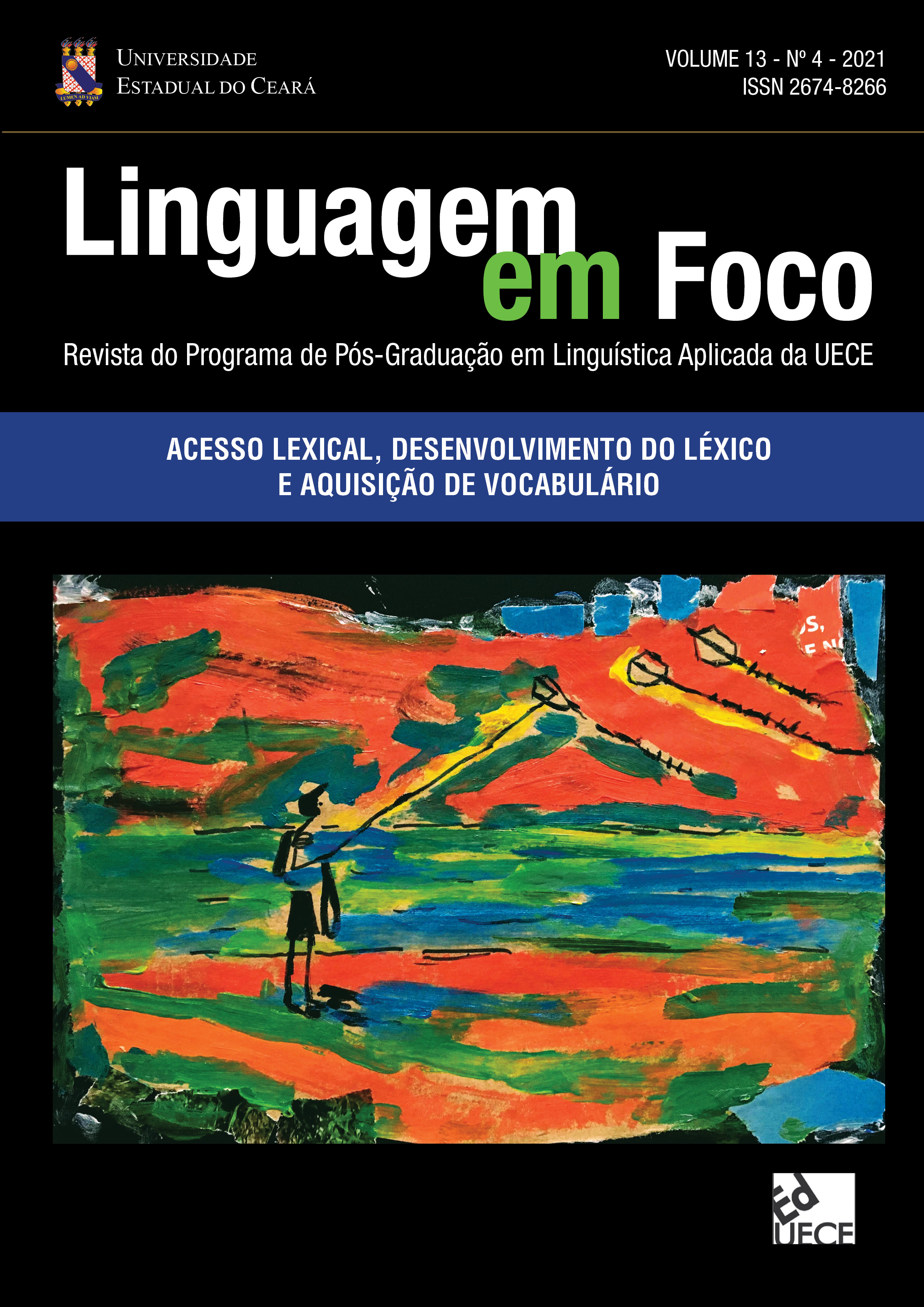Multilíngues em uma comunidade monolíngue
A influência do custo de troca não linguística e da consciência do ambiente linguístico na troca de linguística intencional e não intencional
DOI:
https://doi.org/10.46230/2674-8266-13-7354Palavras-chave:
Multilíngue, Funções executivas, Consciência do Ambiente Linguístico, Troca de código linguísticoResumo
Os multilíngues que vivem em comunidades que também são multilíngues estão constantemente alternando entre os idiomas, enquanto aqueles que vivem em comunidades monolíngues precisam restringir a troca de código linguístico. A Malásia é um país multilíngue onde as pessoas misturam os idiomas diariamente; já em Taiwan, o mandarim é predominantemente usado e as pessoas são mais cautelosas com a alternância entre línguas. Considerando-se essa diferença, no presente estudo, investigamos quais fatores podem auxiliar os estudantes malaios-chineses a reduzir a troca não intencional entre idiomas para se adaptar ao ambiente linguístico de Taiwan. Estudantes malaios-chineses que vivem na Malásia (MNM) e em Taiwan (MET) foram testados para compreender de que forma a troca não linguística e a consciência do ambiente linguístico (CAL) influenciam suas experiências de troca de código linguístico intencionais e não intencionais. A troca de código não verbal dos participantes foi mensurada por uma tarefa de troca de cor/forma, enquanto as experiências de CAL e de troca de código linguística foram medidas por questionários. As análises de regressão múltipla das respostas do grupo MET mostraram que tanto o custo de troca não linguística quanto a CAL foram preditores significativos da troca de código linguística não intencional. Além disso, a análise mostrou que os indivíduos do grupo MET com alto controle executivo tiveram uma troca não intencional dinâmica em que participantes com alto nível de CAL tiveram menores índices de troca não intencional. No entanto, indivíduos do grupo MET com baixo controle executivo tiveram uma troca não intencional mais estática, não influenciada pelo seu nível de CAL. Esses resultados sugeriram que o controle executivo dos multilíngues, juntamente com sua consciência do ambiente linguístico, os ajudam a se adaptar a uma comunidade que tem um idioma predominante em que a troca de código linguístico é reduzida.
Downloads
Referências
ARDILA, A.; RAMOS, E. Normal and abnormal aging in bilinguals. Dementia & Neuropsychologia, v. 2, n. 4, p. 242-247, 2008
BIALYSTOK, E.; MAJUMDER, S. The relationship between bilingualism and the development of cognitive processes in problem solving. Applied Psycholinguistics, v. 19, n. 1, p. 69-85, 1998.
BIALYSTOK, E.; MARTIN, M. M. Attention and inhibition in bilingual children: evidence from the dimensional change card sort task. Developmental Science, v. 7, n. 3, p. 325-339, 2004.
BIALYSTOK, E.; MARTIN, M. M.; VISWANATHAN, M. Bilingualism across the lifespan: The rise and fall of inhibitory control. International Journal of Bilingualism, v. 9, n. 1, p. 103-119, 2005.
BLUMENFELD, H. K.; MARIAN, V. Parallel language activation and cognitive control during spoken word recognition in bilinguals. Journal of Cognitive Psychology, v. 25, n. 5, p. 547-567, 2013.
COLZATO, L. S., BAJO, M. T.; VAN DEN WILDENBERG, W.; PAOLIERI, D.; NIEUWENHUIS, S.; LA HEJI, W.; HOMMEL, B. How does bilingualism improve executive control? A comparison of active and reactive inhibition mechanisms. Journal of Experimental Psychology: Learning, Memory, and Cognition, v. 34, n. 2, p. 302-312, 2008.
FESTMAN, J.; RODRIGUEZ-FORNELLS, A.; MÜNTE, T. F. Individual differences in control of language interference in late bilinguals are mainly related to general executive abilities. Behavioral and Brain Functions, v. 6, n. 1, p. 5, 2010.
Fulfilling your child’s dreams of studying abroad. The Edge Markets. Disponível em: <https://www.theedgemarkets.com/content/advertise/fulfilling-your-child-dreams-of-studying-abroad>. Acesso em: 29 nov. 2021.
GREEN, D. W. Control, activation, and resource: A framework and a model for the control of speech in bilinguals. Brain and Language, v. 27, n. 2, p. 210-223, 1986.
HEREDIA, R. R.; ALTARRIBA, J. Bilingual Language Mixing: Why Do Bilinguals Code-Switch? Current Directions in Psychological Science, v. 10, n. 5, p. 164-168, 2001.
HEUER, S.; HALLOWELL, B. A novel eye-tracking method to assess attention allocation in individuals with and without aphasia using a dual-task paradigm. Journal of Communication Disorders, v. 55, p. 15-30, 2015.
HEUER, S.; PINKE, M. L. Development of an eye-tracking method to assess mental set switching in people with aphasia. Brain Injury, v. 31, n. 5, p. 686-696, 2017.
HOSHINO, N.; KROLL, J. F. Cognate effects in picture naming: Does cross-language activation survive a change of script? Cognition, v. 106, n. 1, p. 501-511, 2008.
LI, P.; ZHANG, F.; TSAI, E.; PULS, B. Language history questionnaire (LHQ 2.0): A new dynamic web-based research tool. Bilingualism: Language and Cognition, v. 17, n. 3, p. 673.680, 2014.
LI, P.; ZHANG, F.; YU, A.; ZHAO, X. Language History Questionnaire (LHQ3): An enhanced tool for assessing multilingual experience. Bilingualism: Language and Cognition, v. 23, n. 5, p. 938-944, 2019.
LOGAN, G. D. On the ability to inhibit thought and action: A users' guide to the stop signal paradigm. In: DAGENBACH, D.; CARR, T. H. (Eds). Inhibitory processes in attention, memory, and language. Cambridge, United Kingdom, Academic Press, 1994. p. 189-239. ISBN 9780122004100.
MARIAN, V.; SPIVEY, M. Bilingual and monolingual processing of competing lexical items. Applied Psycholinguistics, v. 24, n. 2, p. 173-193, 2003.
Malaysia: Overview of Students - 新南向人才培育計畫. Edunsbp.moe.gov.tw. Disponível em: <https://www.edunsbp.moe.gov.tw/overview_students_en1004.html>. Acesso em: 29 nov. 2021.
MISHRA, R. K.; SINGH, N. Language non-selective activation of orthography during spoken word processing in Hindi–English sequential bilinguals: an eye tracking visual world study. Reading and Writing, v. 27, n. 1, p. 129-151, 2013.
MIYAKE, A.; FRIEDMAN, N. P.; EMERSON, M. J.; WITZKI, A. H.; HOWERTER, A.; WAGER, T. D. The Unity and Diversity of Executive Functions and Their Contributions to Complex “Frontal Lobe” Tasks: A Latent Variable Analysis. Cognitive Psychology, v. 41, n. 1, p. 49-100, 2000.
NUNNALLY, J. C.; BERNSTEIN, I. R. Psychometric Theory. New York, McGraw-Hill, 1994. ISBN:978-0070478497
POARCH, G. J.; VAN HELL, J. G. Executive functions and inhibitory control in multilingual children: Evidence from second-language learners, bilinguals, and trilinguals. Journal of Experimental Child Psychology, v. 113, n. 4, p. 535-551, 2012.
POULISSE, N.; BONGAERTS, T. First language use in second language production. Applied Linguistics, v. 15, n. 1, p. 36-57, 1994.
PRIOR, A.; GOLLAN, T. Good Language-Switchers are Good Task-Switchers: Evidence from Spanish–English and Mandarin–English Bilinguals. Journal of the International Neuropsychological Society, v. 17, n. 4, p. 682-691, 2011.
RODRIGUEZ-FORNELLS, A.; KRÄMER, U. M.; LORENZO-SEVA, U.; FESTMAN, J.; MUNTE, T. F. Self-Assessment of Individual Differences in Language Switching. Frontiers in Psychology, v. 2, 2012.
SOVERI, A.; RODRIGUEZ-FORNELLS, A; LAINE, M. Is There a Relationship between Language Switching and Executive Functions in Bilingualism? Introducing a within group Analysis Approach. Frontiers in Psychology, v. 2, 2011.
STARREVELD, P. A.; DE GROOT, A. M. B.; ROSSMARK, B. M. M.; VAN HELL, G. Parallel language activation during word processing in bilinguals: Evidence from word production in sentence context. Bilingualism: Language and Cognition, v. 17, n. 2, p. 258-276, 2013.
TIEGO, J.; TESTA, R.; BELLGROVE, M. A.; PANTELIS, C.; WHITTLE, S. A Hierarchical Model of Inhibitory Control. Frontiers in Psychology, v. 9, 2018.
TABER, K. S. The Use of Cronbach’s Alpha When Developing and Reporting Research Instruments in Science Education. Research in Science Education, v. 48, n. 6, p. 1273-1296, 2017.
ZENTELLA, A. C. Growing up bilingual: Puerto Rican Children in New York. Malden, MA: Blackwell, 1997. ISBN: 978-1557864079
Downloads
Publicado
Como Citar
Edição
Seção
Licença
Copyright (c) 2022 Li-Hao Yeh, Jie Yee Lim

Este trabalho está licenciado sob uma licença Creative Commons Attribution 4.0 International License.
Os autores que publicam na Linguagem em Foco concordam com os seguintes termos:
- Os autores mantêm os direitos autorais e concedem à revista o direito de primeira publicação. Os artigos estão simultaneamente licenciados sob a Creative Commons Attribution License que permite a partilha do trabalho com reconhecimento da sua autoria e da publicação inicial nesta revista.
- Os conceitos emitidos em artigos assinados são de absoluta e exclusiva responsabilidade de seus autores. Para tanto, solicitamos uma Declaração de Direito Autoral, que deve ser submetido junto ao manuscrito como Documento Suplementar.
- Os autores têm autorização para disponibilizar a versão do texto publicada na Linguagem em Foco em repositórios institucionais ou outras plataformas de distribuição de trabalhos acadêmicos (ex. ResearchGate, Academia.edu).





























